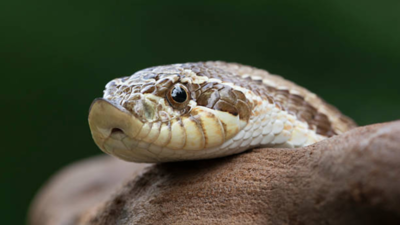ARTICLE AD BOX

You step out into your backyard on a warm sunny day, barefoot, coffee in hand, ready to soak up the morning breeze. You take a few lazy steps toward that pile of firewood or the old potted plants you’ve been meaning to organize… and suddenly, something slithers.Cue the internal scream.Most of us don’t think “snake” when we glance at that innocent-looking pile of leaves or that half-forgotten corner of the garden. But snakes? Oh, they love it. To them, your cluttered backyard is basically a five-star luxury resort. Cozy. Shady. Safe. Full of bugs and rodents for dinner.So where exactly are these sneaky reptiles hiding—and are you unknowingly inviting them in?Let’s dig into the snake-y truth.
Why snakes love your backyard (more than you do)
Snakes aren’t out to get you. Seriously. They’re not slimy villains waiting to ambush. They’re actually shy creatures who just want peace, food, and shelter. Unfortunately, our backyards—especially in the warmer months—offer all three.And contrary to popular belief, snakes don’t just hang out in jungles or remote farms. Suburban homes, apartment complexes, even city gardens can attract them. It’s all about the hiding spots.
That pile of firewood
If your backyard features a stack of firewood or old logs, ding ding ding, we have a winner. This is snake central. Wood piles are: cool and shaded, full of crevices and gaps, often near the ground, usually undisturbed for weeks (or months). Snakes crawl in, curl up, and stay hidden for hours—or days. They especially love it when you stack wood right next to your house. That gives them easy access indoors if they’re feeling adventurous.Tip: Always stack firewood at least 2 feet off the ground and keep it far from your house walls.
Leaf piles and garden debris
You know that leafy, mulchy corner of your garden you swore you'd clean up last Diwali? Yeah, snakes love that too. It's warm, damp, dark, and crawling with insects, frogs, and rats—the perfect snake buffet. Add a broken pot or two and some tangled garden hose, and you've created a custom snake lounge.Tip: Rake leaves regularly, and don’t leave compost or organic trash uncovered.
Rock borders and decorative stones
That fancy rock border around your flower bed? It might look nice, but it’s also a snake’s idea of prime real estate. Snakes slip between the stones and stay cool while waiting for a mouse to wander by. Even decorative fountains and frog ponds can become snake hotspots, especially in summer.Tip: Keep landscaping neat, seal cracks in stonework, and trim tall grass or weeds near the borders.
Unused items left outside
Old tires. Garden boots. A rusted toolbox.
That unused grill. Basically, anything that's been sitting outside untouched for weeks becomes a possible snake shelter. One small opening, and a curious snake can slither right in. And yes, that includes your kid’s forgotten toy box and your dog’s overturned water bowl.Tip: Declutter your backyard! If you’re not using it, store it in a sealed shed or get rid of it.
Tall grass and overgrown shrubs
Snakes are ambush predators. They like to stay hidden until they can strike their prey (usually frogs, lizards, birds, or rodents).
Tall grass is the perfect camouflage.If you haven't mowed in weeks or your bushes are growing wild, you're basically laying out a welcome mat for reptiles.Tip: Keep grass short, trim hedges, and clear out overgrown patches regularly—especially in rainy or post-monsoon seasons.
Bonus snake magnet: Rodents and insects
Here’s the real twist: snakes don’t show up just for shade—they come for food. If your backyard has a rodent issue, it’s only a matter of time before a snake drops by to check things out.And once it finds your yard welcoming, it might just stay.Tip: Keep trash bins tightly closed, seal up holes in fences or walls, and don’t leave pet food or birdseed lying around.
How to tell if a snake’s been hanging around
You might not always see the snake, but here are some signs that one’s lurking:Shed skin: A papery, transparent snake skin is a sure sign one’s living nearby.Slither trails in dusty areas or loose soil.Snake droppings: Gross, but useful. They’re dark, smelly, and may contain bits of bone or fur from their last meal.Missing eggs or chicks: If you have a birdhouse or chicken coop, and the eggs suddenly vanish, a snake might be the culprit.
What to do if you see a snake
Step one: Don’t panic. Step two: Don’t try to be a hero.Unless you’re trained to handle reptiles, don’t try to chase, kill, or catch the snake yourself. Most bites happen when people try to “remove” the snake with a stick or their chappals.Instead:
- Back away slowly and calmly
- Keep kids and pets away
- Call a local snake rescuer or forest department
- Keep eyes on the snake from a safe distance until help arrives
Remember: In many countries, including India, snakes are protected species.
Killing them can be illegal and dangerous.
How to snake-proof your yard without making it ugly
You don’t have to turn your backyard into a sterile wasteland to keep snakes out. Here’s what works:
- Install fine mesh fencing around gardens and chicken coops
- Seal any cracks or holes in outer walls and sheds
- Use solar-powered snake repellents (they vibrate and annoy snakes away)
- Avoid waterlogging in any part of the yard
- Educate kids and domestic helpers on snake-safe habits
Respect the snake, protect your space
Snakes aren’t villains—they’re part of the ecosystem and actually help control pests like rats and frogs. But that doesn’t mean you want one curled up in your rain boots.The best way to stay safe is to stay alert. Know what snakes love, clean up their favorite hiding spots, and take quick action if you spot one slithering where it shouldn’t be.Your backyard should be a haven for you—not a reptile retreat.Disclaimer: This article is for informational purposes only and is not a substitute for professional wildlife or medical advice. Always consult local animal control, forest department, or licensed snake rescuers if you suspect a snake is on your property. Do not attempt to handle or remove snakes yourself, as this can be dangerous and, in some regions, illegal. The content is based on general knowledge and may not apply to all regions or snake species. Reader discretion is advised.



.png)
.png)
.png)
















 3 hours ago
4
3 hours ago
4









 English (US) ·
English (US) ·